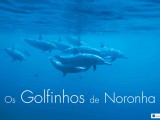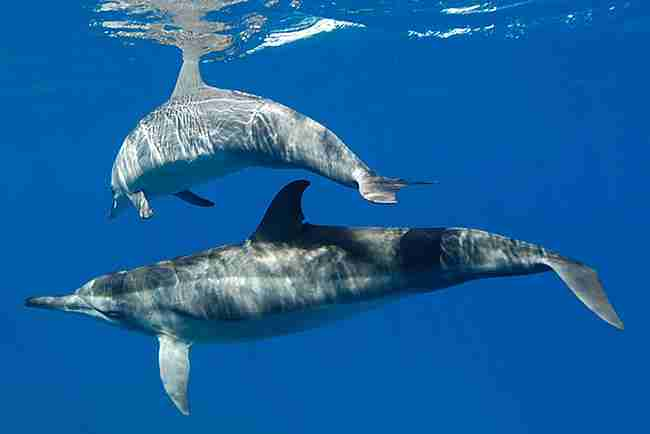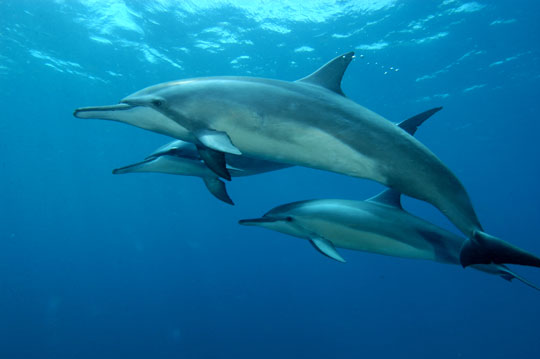Este post também está disponível em:
Português
English

Inside the cove of Baía dos Golfinhos in Fernando de Noronha, one of the natural attractions of the archipelago, there is a high concentration of spinner dolphins, an oceanic and tropical species known for its behavior of jumping out of the water and performing up to seven rotations around its own axis.
Dolphin watching at the site is one of the main tourist attractions of Noronha, whose visit was 25 thousand tourists at the Dolphin Viewpoint and 45 thousand tourists embarked for the observation of the animals (* the figures are from the ‘Spinner Dolphin’ Project).
Project ‘Spinner Dolphin’
According to the ‘Spinner Dolphin’ project, these cetaceans are present there 94% of the days of the year, when groups of up to 2,046 spinner dolphins enter the Dolphin Bay for rest, reproduction, care of calves or seeking protection against shark attacks.
Every day, these animals follow the same routine, a cycle of activities consisting of night feeding, morning movement towards Dolphin Bay, arrival at sunrise and afternoon departure to the feeding areas.
Videos about the Rotator Dolphin

First report of the observation of the Spinner Dolphin
The friar André Thevet was the author of the first report of the observation of dolphins in Fernando de Noronha, in 1556, when he described the presence of those animals surrounding the boats in the archipelago.
Due to the number of animals and their frequency, Fernando de Noronha is known as the most suitable place on the planet to see dolphins, says the president of the ‘Spinner Dolphin’ project, oceanographer José Martins da Silva Júnior.
Created in 1990 and executed by the NGO Centro Golfinho Rotador, this project develops research, environmental education and community involvement actions in favor of the conservation of spinner dolphins, Fernando de Noronha and marine biodiversity.
Rotator Dolphin Project in Fernando de Noronha
The Spinner Dolphin Project (developed by the Fernando de Noronha National Marine Park and the Pro-Noronha Institute) has been active since 1990 in the scientific and continuous monitoring of Stenella lonfiastriz.
The Spinner Dolphin Project (developed by the Fernando de Noronha National Marine Park and the Pro-Noronha Institute) has been working since 1990 on the scientific and continuous monitoring of Stenella lonfiastriz.
The natural behavior of oceanic dolphins is little known by man, due to the difficulties of staying in the open sea.
The archipelago, one of the most important oceanic reproductive sites in the Atlantic, offers the rare opportunity of an environment frequented by a population of hundreds of dolphins.
IBAMA has licensed, via Pro-Noronha, this project for researchers to analyze the habits of spinner dolphins.
Times of entry and exit from the bay, groupings and routines are monitored and recorded so that in the future we can learn more about this species.
Usually, at sunrise, groups arrive at Dolphin Bay, where they spend a good part of the day.
In the middle of the afternoon, they return to the open sea in search of food.
The spinner dolphin (Stenella longirostris) – is a species found only in the open sea. They can reach up to two meters in length and ninety kilos in weight. In the wild, they live for about 30 years. Their biggest predator is the shark.
The Dolphin Bay in Fernando de Noronha is closed to any kind of human interference.
The engines of the boats usually attract the dolphins. Some leave the bay and swim close to the boat. Their jumps exceed two meters above the surface. In each jump, they rotate around their own body, an act from which the name “rotator” derives.
After following the boat for some time, the animals return to their stronghold. According to the natives, this routine or ritual would be part of a defense mechanism of the whole group.
The animals that make contact are, at the same time, greeting, checking and distracting the visitors, so that they do not invade the bay.
Fernando de Noronha Tourism and Travel Guide




















